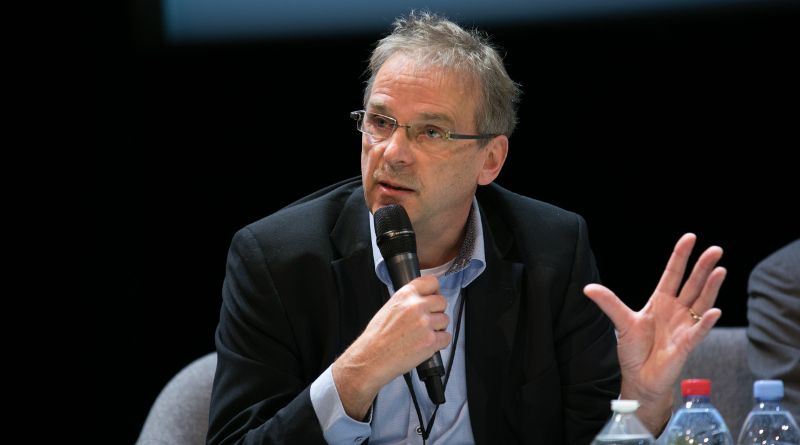Recycling, a review
Looking back to the beginnings of plastics recycling, it becomes clear that since the 1980s, mechanical engineers have developed increasingly from general post-industrial plastics recyclers to highly specialised post-consumer PET recyclers. Making a name for themselves in particular are mechanical engineers in PET recycling from Austria, Germany and Italy. The specialising of PET recycling systems and the founding of individual PET business branches began around the turn of the millennium. To give three examples:
In 1999, Erema receives FDA food approval for the Vacurema bottle to bottle system; continuous development of the Vacumera line specific to different needs; in 2018, Erema and Polymetrix develop a combination made from nitrogen and vacuum line: Vacunite
Starlinger 2004: Installation of the first recoStar PET 125 iV+ for regranulate approved by the FDA for use in food packaging; foundation of Starlinger Viscotec in 2012.
In 2014, NGR brings P:React onto the market. The LSP process utilises the inherent capability of PET to condensate in the molten phase under vacuum. This condensation leads to an increase of IV. The high-performance vacuum effectively decontaminates the material from harmful chemicals, securing further use of the material for 100% food contact.
The processes for PET recycling are constantly giving rise to new technologies. Recyclers have got to the point where they can supply their customers with the desired IV in flake form to suit the final application. Nevertheless, the PET recycling industry sees great challenges ahead. Because of the increasing demand for rPET and the lack of or insufficient collection systems, their customers receive varied, mostly poorer qualities of bales. Higher international quality standards are undercut by the poorer quality. Mechanical engineers therefore face even higher requirements to develop high quality solutions and to satisfy the increasing requests for systems. In addition to mechanical PET recycling, the last five years have seen the development of pilot projects in the field of chemical recycling. This method is seen as a solution supplementary to mechanical recycling and offers the possibility of converting ODRs and making them reusable.
Over the coming pages of our Recycling Special, we have brought together several voices, opinions, conference reports and new developments in the sector. It is clear that the entire PET value creation chain is thrilled by the currently rapid developments in PET recycling!
What about chemical recycling?
PETplanet asked Mr Wim Hoenderdaal, co-chairman of the Petcore Europe PET Thermoforms Working Group, about the actual and future technology developments on chemical recycling.
The chemical recycling process
PETcore Europe has started the special PET industry group called “PET Monomer Recycling”. The reason for choosing the words “Monomer Recycling” instead of “Chemical Recycling” has to do with the fact that there is confusion about the exact meaning of the word Chemical Recycling of Plastics and if all processes falling in this category have a real environmental benefit. Feedstock recycling processes like gasification and pyrolysis can be applied for organic waste or mixed plastic waste and results in Syngas or oil like products. From these products new monomers can be produced. In some countries chemical recycling is considered as not acceptable because of “not enough” environmental benefits. In some cases no compensation is given for the collected mixed plastics when these processes are used. In case of Polyester, de-polymerisation leads directly to the required monomers and avoids a lot of processing steps and energy usage. This is highlighted by using the name “PET Monomer Recycling”.
There are many ways to Rome, same count for the PET monomer recycling technologies that lead to purified monomers like PTA, Ethylene Glycol or BHET. After de-polymerisation a range of technologies can be applied for the purification, mostly a combination of filtration, absorption, distillation, ultra-filtration and crystallisation.
Chemical recycling involved in the PET recycling market
PET monomer recycling will always be complementary to mechanical recycling. When the feedstock (bales) have enough good quality, mechanical recycling can convert them into flakes or pellets that can perfectly be used in transparent bottle to bottle, film and sheet or to applications where colours are acceptable such as strapping. From the roughly 4.0 million tons of PET that is used in Europe for all bottles and thermoforms, only 1.2 to 1.3 million tons are recycled back from bottles into flakes or pellets, meaning that 2.7 million tons are not recovered. This is partly because of lack of collection and partly because of quality reasons. In case we would go to more deposit schemes in Europe, this would extract the good quality bottles enhancing mechanical recycling but at the same time is leaving us with the question of what to do with the rest. Applications that can absorb lower quality bales such as strapping are small and already saturated. It is just an estimation but let’s assume 50% of all PET packaging’s can be recovered by mechanical recycling and the other 50% for PET monomer recycling.
PET monomer recycling is first of all solving the recyclability problem. Recycling starts with the recyclability of the packaging itself, design for recycling, colours, opaque, multilayer, AA scavengers, oxygen scavengers, etc. PET monomer recycling can solve all these problems and make every PET packaging recyclable. Second, it will solve the waste problem, every packaging that is collected can be recycled, no reason to put it to incineration or landfill. Thirdly, it will increase recycling rates. Just assuming 80% of all PET packaging gets collected, mechanical recycling can bring back 40% and monomer recycling can top this up to 80%. And finally, instead of 2-3 times recycling, PET becomes 100% circular and can endlessly be recycled and even be “upcycled”. Not all PET monomer recycling processes will lead to 100% recycle content in one pellet or one bottle. Depending on the technologies and the size of the operations, the recycled monomers will be used over a large quantity of PET production. For solving the waste problem or for the environment, this is equally good. The current trend of claiming and targeting 35% to 50% and even 100% recycle content in some bottles can be challenged. Is there enough good quality rPET to do all this and what if the quality after 2-3 times recycling of a bottle with >50% rPET has gone down. We have to realise that specifying rPET content by governments is a tool and not a target. It tries to create a value to PET packaging waste and stimulate collection. Target is to solve the waste problem, waste on the streets, waste in the ocean and to re-use our raw materials as much as we can.
Still a lot of work has to be done and high expectations have to be answered. This will take time. This year we may see the first semi-commercial scale production of 10.000 t recycled monomers and more will follow.
Voices from the industry
Mr Paul Niedl, Commercial Head at Starlinger Recycling Technology
PETplanet: Since 2002, there has been a Recycling Division at Starlinger. 10 years later in 2012, the Viscotec division, which looks after entire rPET solutions, was founded. What was the deciding factor in founding Viscotec?
Niedl: The business unit Viscotec was founded to better serve the market for PET solid state polycondensation and PET sheet extrusion. The business unit Starlinger recycling technology serves the market for PET bottle-to-bottle recycling along with other pelletising applications such as PE, PP, PS, and nylon, amongst others. Since PET solid state polycondensation and PET sheet extrusion is quite specific and a growing market, it did make sense to found a separate business unit for that.
PETplanet: Over the past six months, Starlinger has seen an increase in installed plants and installed capacity of 5.4% and 5.3%, respectively. Do you see further growth in the field of PET recycling? If yes, over what period?
Niedl: I can only speak about the growth numbers of PET bottle-to-bottle recycling, as this is the market that Starlinger recycling technology is involved in. The market was good until 2013 but a bit slow in 2014-2016 until it grew again in 2017. Since 2018, the market has gone through the roof all over the world; I’d say our business in this segment has quadrupled and there is no end in sight. This development is due to changed consumer perception about recycling, but certainly recycling quotas set by individual countries further support this growth.
PETplanet: There is more and more talk about what is called chemical recycling. How do you rate this technology? Would that be a field where Starlinger would be involved?
Niedl: Chemical recycling has been around since decades, but what we see now is a kind of renaissance. In the past these processes have been too expensive to compete with mechanical recycling for regular applications. Now there are many new initiatives on a pilot scale. Such new approaches could complement mechanical recycling for difficult recycling applications such as multilayer or multi-material structures, but we will have to see once they get beyond the pilot scale if such chemical recycling approaches are cost-effective for a regular scale project.
Dr. Stephan Gneuss, Managing Director at Gneuss
PETplanet: Founded in 1983, Gneuss was initially specialised in melt treatment for the extrusion of profiles, pipes and plates and the production of compounds. When and why was plastic recycling a topic for Gneuss?
Gneuss: As a manufacturer of filtration systems for polymer melts, recycling was a big topic from the beginning. The first focus was on industrial waste recycling. A big impact on the company started, when we broadened our focus to include post-consumer recycling, particularly PET from drinking bottles, which was already available in decent quantities and qualities at that time. In general you can say that the development of the company with regard to recycling was driven by customer demand as well as by technical developments made by Gneuss, such as the recycling filtration system RSFgenius and the degassing extrusion system MRS.
PETplanet: The PET recycling industry has been very busy for quite some time now: the new EU directive of Plastic Strategy and the commitments of the big brand owners (Coca Cola / Nestlé / Pepsico etc.) to use more rPET in products are leading to a huge demand for rPET. One would assume that this also has a positive effect on the recycling system manufacturers – is this the case with Gneuss?
Gneuss: There is a clear trend for growth in the bottle-to-bottle market segment driven by the relatively high prices achievable for rPET pellets. This is obviously a consequence of the new EU Directive of Plastic Strategy and the commitments of the big brand owners. However, the European bottle-to-bottle market is already quite mature. Inside the EU there are only few new players in the market. Most of the growth is taken up by the already existing big players. This situation differs a lot in the rest of the world since some markets are more and some less developed in this aspect.
The consequences on the sheet market and also for fibre producers are not overall positive. The use of bottle flakes is quite common in these market segments, however it is tied to the availability of bottle flakes in a suitable quantity and quality. Due to the strong demand increase by the bottle-to-bottle market this is getting more and more difficult.
Also, the waste streams regarding PET bottle flakes are more and more controlled by a small number of market players. This makes access to bottle flakes increasingly difficult for small and medium sized companies with little connection to the waste market, as it is typically the case for sheet producers. We expect this to be the main limitation for the future development of the PET recycling market: accessibility to bottle flakes.
This is not only a EU specific situation. However, taking a global look, the situation differs very much from country to country.
PETplanet: Gneuss offers a bottle-to-bottle recycling system especially for PET recycling. What are the special features of this system?
Gneuss: The bottle-to-bottle market was important for us from the very beginning with regard to our filtration systems. When we introduced the MRS extrusion system about 12 years ago, we were able to offer a new feature: decontamination of PET in one simple extrusion process without prior treatment of the flakes or an SSP. This system has been successfully implemented in a number of bottle-to-bottle lines in the meantime. However, the main focus lies on thermoforming sheet where food contact approval plays an equally important role.
Also, the fibre industry (which is still the main processor of PET bottle flakes) plays a very important role for our business. At the last K-show we introduced our “Jump” polymer reaction technology which allows an IV built up in the melt phase within just a few minutes. This offers new possibilities for the bottle-to-bottle recycling process.
Due to the limited access of many companies to PET bottle flakes with a sufficient quality (e.g. little amount of foreign polymers), we, as a technology developing company, have been focusing in the last few years on technical improvements. New technologies, which allow the PET processor to work with low quality recycling materials and PET waste from alternative sources (such as post-consumer thermoforming sheet packaging). In the long term, we expect better collection and sorting logistics and technologies to be able to create a larger amount of well recyclable polymers in decent qualities. But in the short and medium term we need to focus on technologies which allow the processor to produce good quality products even with low quality input materials.




